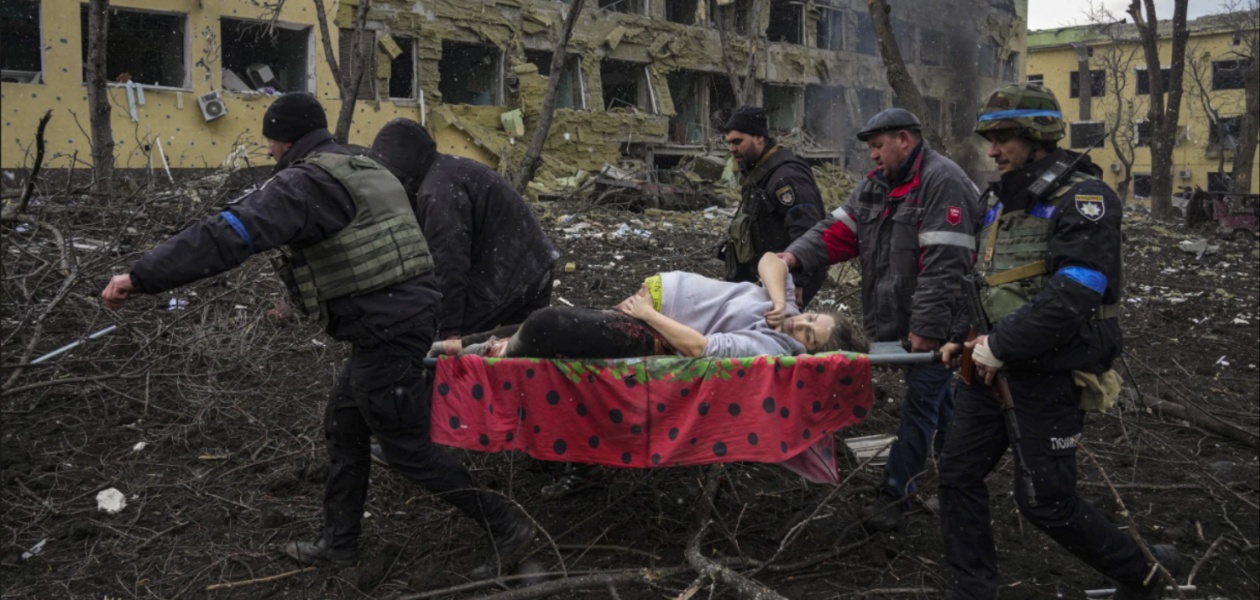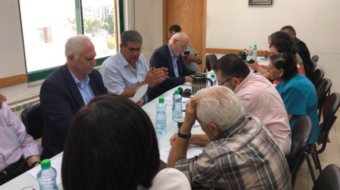
A group of former top U.S. diplomats has been conducting secret peace talks with officials at the highest level of the Russian government since at least April with the goal of negotiating an end to the war in Ukraine. That according to NBC News, which published an exclusive report on the talks Thursday just ahead of the 500-day anniversary of Russia’s invasion of its neighbor and as the Biden administration announced a new $800 million weapons package for Ukraine.
Among the goals of the meetings are setting terms for official negotiations and compromises to bring the fighting—which is essentially at a stalemate—to a conclusion. It is not yet clear how often the discussions have been taking place, if they are part of a single coordinated effort, or whether Wagner mercenary Yevgeny Prigozhin’s coup attempt has affected Russia’s willingness to talk.
Participating in the back-channel diplomacy on the U.S. side has been Richard Haas, a major figure in shaping U.S. foreign policy for decades. He is currently president of the Council on Foreign Relations. Previously, he served as a policy planner at the State Department, a close advisor to former Secretary of State Colin Powell during the George W. Bush administration, a U.S. peace envoy to Northern Ireland, and coordinator of the U.S. occupation of Afghanistan.

Along with Haas, there is Georgetown Professor Charles Kupchan, a senior director of European Affairs on the National Security Council under both Obama and Clinton and a former State Department staffer. Thomas Graham also participated; he was the second Bush administration’s in-house Russia expert and a diplomat previously stationed in the Soviet Union and later Russia. Former Defense Department official Mary Beth Long, a specialist in NATO issues, was involved, along with several other unnamed persons.
Representing Russia, according to NBC, was Foreign Affairs Minister Sergey Lavrov—the man in charge of international policy for President Vladimir Putin. Lavrov reportedly first met with the Haas-led group in New York in April when attending a U.N. meeting. A number of Russian academics and others in the Moscow foreign policy establishment who “have Putin’s ear” have also taken part.
Working the back-channels
Though none of the U.S. participants are current employees of the Biden administration, there is a long history of what in foreign affairs parlance is known as “Track Two diplomacy.” Private citizens not technically representing their government have often conducted talks in situations where it is embarrassing or politically compromising for official state actors to make the first move.
Such “Track Two diplomacy” has played a key role in the past in laying the ground for arms control talks, for instance. In 1994, former President Jimmy Carter went to North Korea for preliminary nuclear weapons program discussions that later produced a treaty. Such talks also led to the 1993 Oslo Peace Accords between Israel and Palestine.
Though those instances of Two-Track diplomacy led to breakthroughs in lowering tensions, the leaked story of the Haas-Lavrov peace talks—at least for now—is proving troublesome for all sides involved, though for differing reasons.

The revelation that influential figures in the Washington diplomatic establishment have been discussing a ceasefire in bilateral meetings with Russia without the participation of—or possibly even the knowledge of—the Ukrainian government gives credence, some say, to the view that the war is, at its core, a U.S.-Russia conflict.
Oleg Nesterenko heads up the European Trade and Industry Center, an intermediary that helps European companies establish operations in Russia. A regular but controversial fixture on the European news commentary scene, Nesterenko has said the root causes of the war “lie with the United States.” In an interview with the French publication L’Éclaireur des Alpes, he said, “It’s not the Ukrainians who have decided or are deciding anything—they’re just performers and victims in a great game that’s way beyond them.”
Denials from all sides
Eager to dispute any notion that the Ukraine-Russia dispute is really a proxy battle between the U.S.-led NATO military alliance and Russia, however, the Biden administration rushed to declare that it did not sanction the Haas team’s efforts—though it has been regularly updated on their progress.
White House spokesperson John Kirby told CBS that the administration was “aware” of the discussions, but they were “not engendered by us.” Sticking to the official line that only the government in Kiev can decide the future of Ukraine, the State Department repeated President Joe Biden’s past declaration of “Nothing about Ukraine without Ukraine.”
It also said the U.S. will continue providing weaponry so that President Volodymyr Zelensky and Ukraine “can negotiate from a position of strength when they think the time is right.” As recently as last month, Secretary of State Antony Blinken explicitly denounced countries like China and South Africa that called for a ceasefire, but signs are emerging that the U.S. and its NATO allies may think the “right” time for negotiations is fast approaching.
In a secret trip to Kiev two months ago, CIA Director William Burns talked with Zelensky about how Ukraine’s much-vaunted “spring offensive”—now stretching into July—would aim to “pressure” Putin into peace talks by the end of the year.
The leaders of several NATO countries, whose economies have borne some of the worst burdens of the war’s fallout in terms of inflation and exploding energy prices, will reportedly tell Biden when they meet with him in Lithuania next week that they do not want to admit Ukraine into their military pact. NATO’s eastward expansion and the prospect of Ukraine joining the alliance was a key reason Russia offered for launching its invasion.

Biden administration officials and Democratic Party strategists would also apparently like to start working toward an endgame for the open stage of fighting in Ukraine before the 2024 U.S. elections. A number of Republicans have already signaled their intention to trim funding for Ukraine, and Democrats are worried that an endless stalemate in the east will become a political liability for the president.
In Moscow, where the fallout from the Prigozhin mercenary rebellion is still not settled, the Putin government appears determined to not give away any details of discussions it might be involved in concerning the war. Maria Zakharova, a spokeswoman for the Russian Foreign Ministry, simply called the NBC report “fake news” and said it was “disinformation spread by Western media.”
The Russian leadership has likely realized by this point that Putin’s intention to erase the existence of the Ukrainian state will not be realized. The right-wing government that came to power in Kiev following the 2014 U.S.-backed coup will probably remain, for now, with Zelensky at its head, still supported financially and militarily by the U.S. and NATO.
Any designs Russia may have had on recreating the old Czarist empire will also likely have to be shelved in favor of gaining security guarantees in relation to NATO and Ukraine. If any peace is to be achieved, Moscow will probably have to settle for the Russian army’s current territorial gains.
As for Ukraine, an official in Zelensky’s office would offer no specific comment on any possible talks but tried to dissuade observers from concluding Ukraine was being left out of negotiations on its future: “Our position is unchanged—the fate of Ukraine cannot be decided without Ukraine.”
Voices in favor of continuing the fighting also weighed in. Matt Dimmick, a former Russia and Eastern Europe director for the NSC, said discussions of a potential U.S.-Russia deal undercut Ukrainian claims of sovereignty in its affairs.
“Ukraine doesn’t need and want intermediaries to start coming in and crafting ceasefire solutions and then enticing Europe and the U.S. to elbow Ukraine in that direction,” Dimmick said. Ukraine’s “path to a secure future,” he argued, “is driving right through Russian defenses and leaving Russia no choice but to come up with their own way out of Ukraine.”
“I worry what messages might be conveyed [by peace talks]…and the implicit signal that we’re desperate for a deal,” Bradley Bowman, a former Senate aide and current researcher at the Foundation for the Defense of Democracies think tank, said. “Right now, what we really want to do is isolate and put pressure on Putin.”
For now, more bombs
The announcement Friday by President Joe Biden that the U.S. will be sending a new $800 million weapons package for Ukraine that includes horrifyingly lethal cluster bombs may, at first glance, look like a development that could upset any peace process. In reality, it very well could be part of the strategy to beef up Ukrainian offensive capabilities to increase U.S. leverage in negotiations with Russia.
Cluster bombs are weapons that break apart in the air and release multiple smaller explosives across a wide area. They can be delivered via planes, artillery, or missiles. They are designed to detonate when they hit the ground and kill anyone nearby—whether military or civilian. The Red Cross reports that up to 40% of them don’t detonate on impact, and thus remain as long-term threats to civilians, much like landmines.
Human rights groups condemn the munitions, saying 60% of the people they have killed in previous wars were not soldiers; one-third of their victims are children. U.S. law generally forbids exporting them, but Biden will waive that law to allow some classes of cluster bombs to be sent to Ukraine.
The U.S. dropped 260 million cluster bombs in Southeast Asia between 1964 and 1973, and the vast majority still remain unexploded on the ground, where they will endanger civilians for generations. Russia has reportedly deployed cluster bombs in Ukraine during the current war, a fact that Washington is using to justify its own exports of the munitions.
Neither the U.S., Russia, nor Ukraine have signed the international treaty outlawing cluster bombs.
What would a deal look like?
All the intrigue, official distancing, and fresh weapons shipments aside, speculation is also raging over what a potential peace deal might look like. Previous statements by Haas and Kupchan give some idea of what they may have talked about with Lavrov.
In the April 2023 issue of Foreign Affairs, the pair authored a long article titled “The West Needs a New Strategy in Ukraine,” in which they focused on “getting from the battlefield to the negotiating table.” They predicted that following a largely moot Ukrainian counteroffensive in the spring and summer, the war would likely deteriorate into a bloody stalemate, a war of attrition with neither side making any great gains.
After arming Ukraine to a level sufficient for it to uphold the current frontiers, Haas and Kupchan encouraged the U.S. to begin looking for a negotiated settlement. Next, a “demilitarized zone” of sorts could be established along the current frontline with an international organization like the U.N. providing monitors to prevent more fighting. Such a ceasefire would then allow for broader long-term negotiations.

Should such a strategy be pursued, it would likely mean that Crimea and much of the eastern Donbas region would remain under Russian control, contrary to repeated demands from Ukrainian and U.S. officials that all former Ukrainian territory must be vacated by Russian forces. Such a bout of realpolitik could defuse the impasse of the current moment and mark a return to practical rather than propagandistic principles of diplomacy.
The price of peace?
If the report of high-level U.S.-Russian negotiations is true, if those negotiations have made progress toward a true ceasefire, if the Ukrainian leadership can be cajoled by their NATO backers to accept a deal, and if the instability in the Russian military has not thrown everything into disarray—then there may be a way out of this war that doesn’t require tens of thousands of more Ukrainian and Russian deaths. There may be an exit strategy that doesn’t lead to nuclear annihilation.
That’s still a lot of ifs.
Should they all materialize, though, it would mean arriving back, essentially, at the terms that were in the Minsk Accords of 2015 and in the Ukraine-Russia negotiations that happened in Istanbul in the weeks right after the war started. Both of those potential settlements were scuttled by Ukraine under U.S. and NATO pressure.
Among the outcomes if a ceasefire is concluded: The effective borders between Russia and Ukraine would be set at their current frontlines; Ukraine will not be a member of NATO; Russia will be militarily weakened and prevented in the short term from playing a major role in any future U.S.-China conflict; U.S. dominance within Europe will be reasserted and secure; U.S. fossil fuel companies will have squeezed their Russian competitor out of the European market; and the profits of major weapons makers will be far healthier than they were 500 days ago.
From the looks of things, that may end up being the price of peace in Ukraine.
We hope you appreciated this article. At People’s World, we believe news and information should be free and accessible to all, but we need your help. Our journalism is free of corporate influence and paywalls because we are totally reader-supported. Only you, our readers and supporters, make this possible. If you enjoy reading People’s World and the stories we bring you, please support our work by donating or becoming a monthly sustainer today. Thank you!












Comments